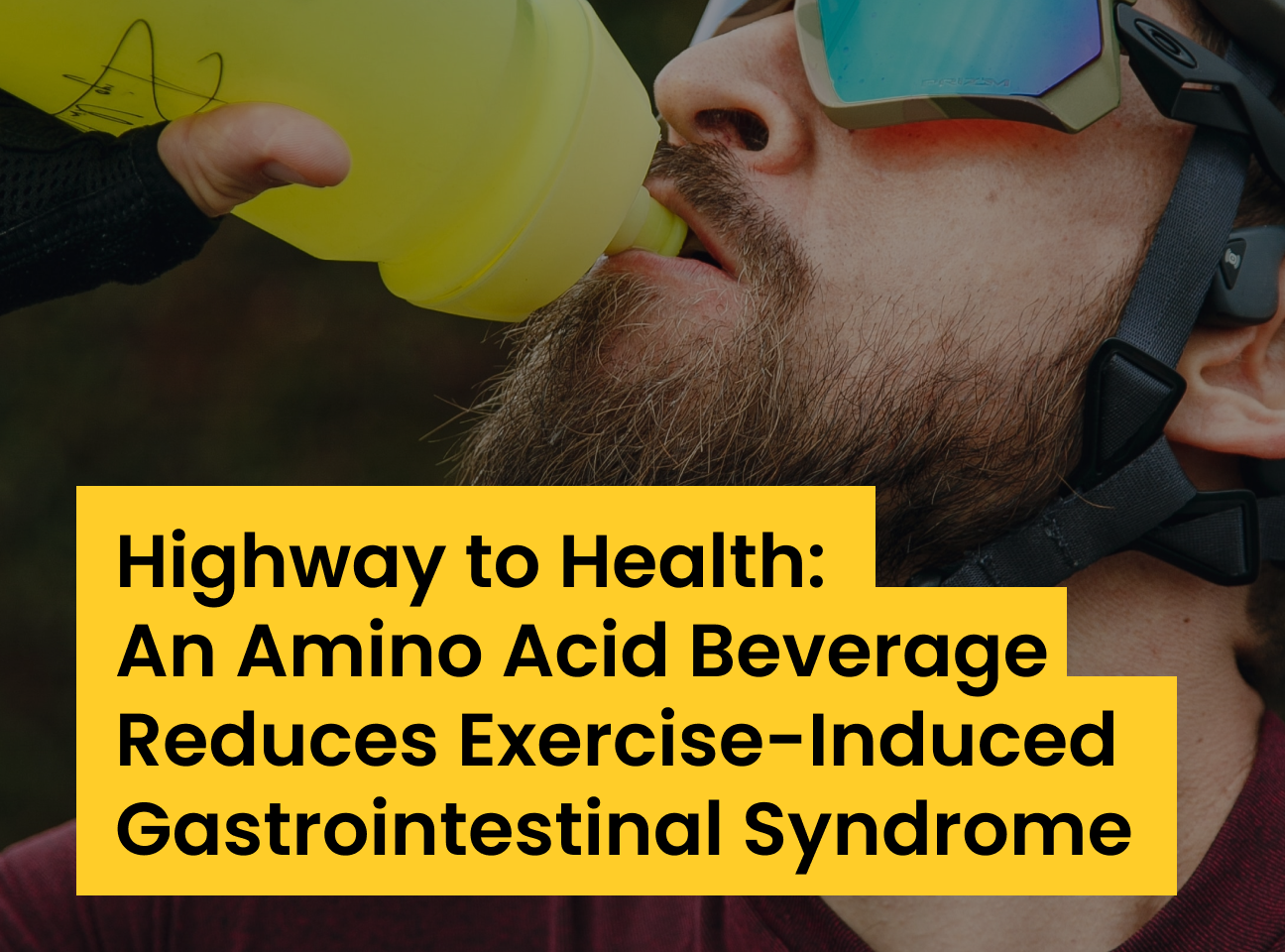
Highway to Health: An Amino Acid Beverage Reduces Exercise-Induced Gastrointestinal Syndrome
By Alex Ritson MSc, Head of Education

Research:
Amino Acid-Based Beverage Interventions Ameliorate ExerciseInduced Gastrointestinal Syndrome in Response to Exertional-Heat Stress: The Heat Exertion Amino Acid Technology (HEAAT) Study by Costa et al. (2023)
Context:
Picture your digestive system as a well-organised highway. Its job is to ensure that cars (food particles) reach their intended destination (areas of the body) like clockwork. Give or take a small amount of traffic congestion (stomach distension) from time to time, say after eating a large meal, traffic flow usually runs smoothly. Performing strenuous, long-duration exercise, however, is like construction on a highway. Traffic flow becomes severely disrupted (digestion), resulting in traffic jams (gastrointestinal symptoms). In the body, this is due to increased exercise-induced stress hormone release, sympathetic nervous drive, and reduced blood flow to the gut. This process is called ‘exercise-induced gastrointestinal syndrome’ (Costa et al., 2017) and is common in endurance athletes performing strenuous exercise. Temperature (exercising in hot, humid conditions) further exacerbates this issue. It is like hot weather on a highway causing the asphalt and cement to expand leading to cracks in the road (cellular injury and increased gut permeability). These cracks can lead to debris (foreign particles) and some vehicles (food particles) veering off their designated path. Just like how debris and vehicles going off-road can be dangerous, certain particles such as bacteria translocating from the intestine into circulation can cause an immune response resulting in local or systemic inflammation. Previous experiments have attempted to improve blood flow and support intestinal epithelial integrity and function through various nutrition interventions during exercise. The most meaningful change to date has been the consumption of whey protein hydrolysate (15 g) before and during strenuous exercise, which reduced intestinal epithelial injury and intestinal permeability. However, this resulted in gastrointestinal symptoms (Snipe et al., 2017). Therefore, this study assessed an alternative amino acid formulation on proxy measures of intestinal epithelial integrity, inflammation, and gastrointestinal symptoms in response to exercise performed in the heat.
The study:
This was a randomised, double-blind, counterbalanced experiment. Twenty trained (V̇O2 max 59.6 ml/kg/BM-1.min-1; training load: 288 min/wk) runners not acclimated to training in the heat were assigned to two running trials (60% of each participants V̇O2 max) in the heat (34.6 degrees, ~38% relative humidity) with at least one-week washout between trials. Participants received one of two types of amino acid beverages (named ‘VS001’ or ‘VS006’) for seven days before the experiment and every 20 min during the exercise trials. Participants also served as their own control by adhering to the same protocol but consuming a water placebo (CON) for the same period. Importantly, this trial was not designed to compare the effects of the amino-acid formulations against each other; rather, it was intended to compare each formulation against the control condition. Proxy blood markers of intestinal epithelial injury (I-FABP – a protein found in the lining of the intestine), bacterial infection (soluble CD14 – a receptor that binds to endotoxins), and immune cells (interleukins, tumour necrosis factor and anti-endotoxin antibodies ‘IgM’) were measured. In addition, gastrointestinal symptoms were assessed via a questionnaire.
Essential knowledge: What does counterbalance mean?
Counterbalancing participants is a method of varying the order of treatments (e.g., amino acid formulation [either VS001 or VS006] -> CON; or CON -> amino acid formulation [either VS001 or VS006]) across participants to control for any treatment order or learning effect biases. For instance, participants may perform better in the final condition because of their familiarity with the intervention. By randomising participants and counterbalancing the study design, any biases due to familiarity with the interventions are equally balanced between groups, enhancing the validity of the results.
Findings:
When consuming the amino acid beverages, the runners showed reduced signs of gut injury compared to the water condition. Moreover, the runners showed reduced symptoms of inflammation, although this only reached significance when runners consumed the VS001 drink. What’s more, unlike previous trials using protein supplements, such as whey hydrolysate (Snipe et al., 2017), the runners didn’t report an increase in gastrointestinal symptoms. The results suggest that the amino acids are helping to keep the intestinal epithelial and protein-tight junctions at their required permeability and distance, thereby preventing harmful substances from getting into the bloodstream. In other words, the amino acids are acting as roadside maintenance crew, providing extra asphalt to help prevent the road (intestine epithelial) from cracking (permeability and tight junctions), particularly during hot conditions, thereby preventing debris and vehicles (harmful bacteria) from going where it shouldn’t (the blood).
Relevance:
Regular consumption of an amino acid beverage (237 ml of either 4.5g/L [VS001] or 6.4 g/L [VS006] of amino acids) and during strenuous exercise (every 20 minutes) and immediately after, helps prevent damage to the gut, without exacerbating gastrointestinal symptoms in the heat. Nutrition practitioners working with athletes susceptible to gastrointestinal symptoms should keep tabs on this research as it evolves in the coming years. It’s worth noting that the only amino acid formulation used in this experiment that is commercially available is the VS001 product (enterade IBS-D). However, the cost of purchasing a pack of six (6 x 237 ml) is $29.99, as of August 2023. If we consider that athletes consumed a 237 ml bottle every 20-mins during exercise, the practicability of using such a supplement at this time is limited to those with ample funding. The researchers did not disclose the ingredients for the VS006 due to ‘intellectual property licensing’, but it did contain amino acids in the following sequence: aspartic acid, serine, valine, isoleucine, threonine, and tyrosine. Hopefully, as the research evolves and the blend of amino acids and other components become disclosed, more affordable products will be made commercially available, and most importantly, products will be tested for banned substances and approved for athletes. For now, practitioners looking to incorporate a nutritional strategy into their arsenal to help mitigate gastrointestinal symptoms may want to stick to evidence-based strategies such as gut training, and early/frequent consumption of carbohydrates and fluids pre/during exercise within the athlete’s tolerance level.
Recommended reading: Gastrointestinal Assessment and Therapeutic Intervention for the Management of Exercise-Associated Gastrointestinal Symptoms: A Case Series Translational and Professional Practice Approach by Gaskell, Rauch, & Costa (2021) (open access)
Complement this research with the We Do Science podcast episode: Sport Supplements and the Athlete’s Gut with Dr. Patrick Wilson PhD
References:
Costa, R. J. S., Snipe, R. M. J., Kitic, C. M., & Gibson, P. R. (2017). Systematic review: Exercise-induced gastrointestinal syndrome-implications for health and intestinal disease. Alimentary Pharmacology & Therapeutics, 46(3), 246–265. https://doi.org/10.1111/apt.14157https://doi.org/10.1111/apt.14157****
Snipe, R. M. J., Khoo, A., Kitic, C. M., Gibson, P. R., & Costa, R. J. S. (2017). Carbohydrate and protein intake during exertional heat stress ameliorates intestinal epithelial injury and small intestine permeability. Applied Physiology, Nutrition, and Metabolism, 42(12), 1283–1292. https://doi.org/10.1139/apnm-2017-0361
